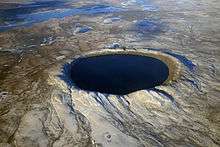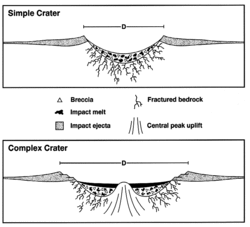Tswaing crater
| "Place of Salt" | |
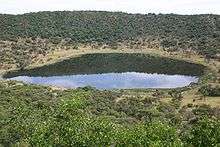 The crater at Tswaing | |
 The museum in relation to Gauteng | |
| Location |
Pretoria, Gauteng, |
|---|---|
| Coordinates | 25°24′31″S 28°04′57″E / 25.408486°S 28.082529°E |
| Type | Natural history |
| Public transit access | Onderstepoort Road ( M35), Soshanguve, Pretoria |
| Website | http://www.ditsong.org.za/tswaing.htm |
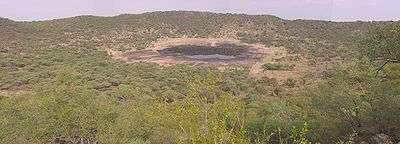
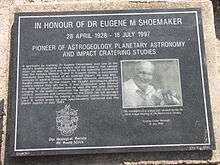
Tswaing is an impact crater in South Africa that is accompanied by a museum. It is situated 40 km to the north-west of Pretoria. This astrobleme is 1.13 km in diameter and 100 m deep [1] and the age is estimated to be 220,000 ± 52,000 years (Pleistocene).[2] The impactor is believed to have been a chondrite or stony meteorite some 30 to 50 m in diameter that was vaporized during the impact event.[2][3] Morokweng crater, another crater of chondrite origin, lies north-west of Vryburg.
Etymology
The name Tswaing means Place of Salt in Tswana and the crater was also formerly known in English: as Pretoria Saltpan crater and in Afrikaans: as Soutpankrater.
History
Stone tools from the Middle Stone Age show that the crater was regularly visited by people from as far back as 100,000 years ago in order to hunt and collect salt. Water in the crater comes from surface springs, ground water and rain water and is rich in dissolved carbonates and sodium chlorides. Tswana and Sotho people harvested the salt by filtering and decoction between 1200 and 1800. Between 1912 and 1956 brine was pumped from the floor of the crater by the company SA Alkali Ltd. in order to extract soda and salt.[4]
A scientific dispute was ongoing regarding the origin of the crater between supporters of volcanic origin (Wagner, 1922) and those who believed it is an impact crater (Rohleder, 1933) until 1990, when examination of the core from a borehole proved that it is an impact crater.[5]
Tswaing is currently on the tentative list for consideration as a World Heritage Site.[6]
See also
| Wikimedia Commons has media related to Tswaing crater. |
References
- ↑ Reimold, W.U. (1998-04-27). "Meteorites and Meteorite Craters". South African Astronomical Observatory (SAAO). Retrieved 2008-08-23.
- 1 2 "Tswaing and its environmental effects". Lunar and Planetary Institute. Retrieved 2008-08-23.
- ↑ "Tswaing". Earth Impact Database. University of New Brunswick. Retrieved 2009-08-16.
- ↑ Tswaing information leaflet
- ↑ "Tswaing crater". Wondermondo.
- ↑ "Tentative Lists, Tswaing Meteorite Crater". UNESCO. 2004-05-15. Retrieved 2008-08-23.
External links
- Tswaing Meteorite Crater
- Hartebeesthoek Radio Astronomy Observatory writeup on the crater
- City of Tswhane - Tswaing Meteorite Crater
Coordinates: 25°24′32″S 28°4′58″E / 25.40889°S 28.08278°E
